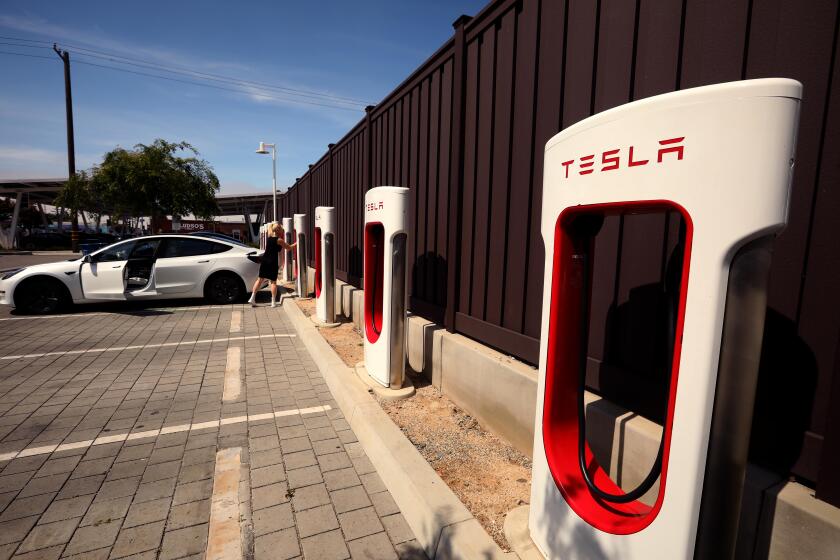Current Events
How do Americans view the rich potential of electric-vehicle development these days? Oliver Hazimeh has a succinct answer. “People are getting electrified about it,” he said with a chuckle. “They’re charged up.”
Hazimeh should know. He works with vehicle manufacturers, battery and component makers and government entities, among others, helping them leverage opportunities in the fast-emerging electric vehicle market.
“It’s a global race that’s been kicked off,” he said. “What’s different now from the 1990s is that this is the convergence of multiple major drivers and factors: technology, energy independence, climate concerns and the auto industry‘s recent crises, which gave rise to smaller players with a different model.”
Many of the early players in that global race will be on display at the Los Angeles Auto Show this week. According to show spokesman Brendan Flynn, at least 15 electric vehicles will appear. “We consider this year to be the beginning of the modern electric car era,” he said.
Leading the charge are this fall’s big newsmakers, the Chevy Volt and Nissan Leaf. Each gets a big thumbs-up from auto industry pundits who’ve driven them. One is Joe Wiesenfelder, senior editor for Chicago-based Cars.com, who tooled around in both the Volt and the Leaf last month.
The Volt makes good on General Motors’ promises, he said.
“What we never knew until now was how well it drives, how comfortable it is and how real a car it is. We’ve been conditioned to think of electric cars as city cars that don’t go real quick. This is a real car. Once you get up to speed on the highway, it’s very quiet, rides very well and feels substantial and solid in a good way.”
Similar high marks come from James Bell, executive market analyst for Irvine’s KBB.com (the Kelley Blue Book website), who feels Volt will impress many buyers. In driving the Volt, Bell sensed GM had really sweated the details. Drivers who stay within the 40-mile all-electric range and don‘t have to use the gas-powered range extender “might literally have to visit the gas station just two or three times a year,” he said.
The Volt’s chief rival, the Nissan Leaf, is the first mass-marketed battery-electric car intended for sale across the nation and world, Wiesenfelder said. Its 100 miles of range is about what’s promised by other battery-electric vehicles.
For an overwhelming number of drivers, that will be plenty. “What these cars will teach people is how little they actually drive each day,” he said.
The Coda, by Santa Barbara-based Coda Automotive, is likely the next most notable EV. “It’s an interesting story,” Bell said. “You have U.S. know-how and smarts combined with Chinese production efficiencies.”
With its conservative styling, the Coda is an understated and quietly dignified electric affair. It will have limited distribution and a $45,000 price sticker, which will be offset somewhat with state and federal tax breaks. “They’re looking to scoop up some customers in the wake of the Leaf and Volt,” Bell said.
Making its world debut at the auto show will be the Wheego LiFe, Flynn said. “Wheego has been around a long time, but has always produced low-speed vehicles. This is their first viable freeway-capable vehicle.”
Mitsubishi will also generate a current of excitement, unveiling the North American version of its i-MiEV electric vehicle, Flynn said. And Toyota will offer showgoers an electric version of the RAV4, the result of a partnership with EV pioneer Tesla, he added.
And numerous other electric vehicles will grace the show, as well, Flynn said. The Honda FCX Clarity and the Mercedes-Benz F-Cell are electric vehicles whose onboard electricity is generated by hydrogen fuel cells. Jaguar has an electric supercar concept called the C-X75, whose gas range extender features Volt-like technology. In addition, Saab’s 9-3 ePower will be showcased and Smart will show off its Smart
fortwo EV, Flynn said.
The EVs at the show are likely to be just the first in a wave of electric vehicles to come. “OEMs need to stop thinking of them as green vehicles,” Hazimeh said. “These cars can be much more.”
— Paul Rogers, Custom Publishing Writer



